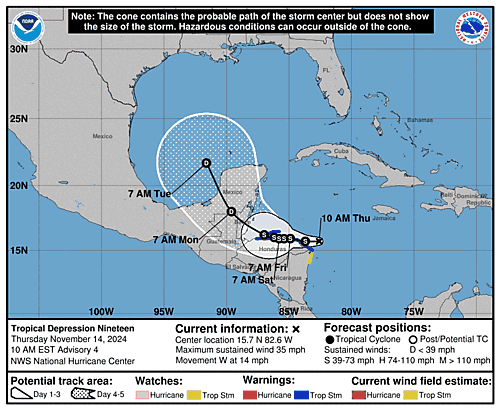Issued at 500 PM AST Tue Sep 06 2022
000 WTNT41 KNHC 062100 TCDAT1 Tropical Storm Earl Discussion Number 16 NWS National Hurricane Center Miami FL AL062022 500 PM AST Tue Sep 06 2022 Earl has become somewhat better organized this afternoon. After the previous reconnaissance mission concluded, deep convection increased closer to the low-level circulation, with evidence of deep convection rotating more up-shear on convectional satellite imagery. An AMSR2 microwave pass at 1728 UTC also showed this improved structure, with a formative inner core with at least 50 percent convective coverage, though it was still evident that the mid-level center remains displaced to the northeast. This afternoon's Air Force Reserve Reconnaissance mission confirmed Earl has strengthened from this morning, with peak 850 mb flight level winds of 72 kt and SFMR at 63 kt. The second pass through also had a minimum pressure of 991 mb. These values support increasing the initial intensity to 60 kt this advisory. Aircraft fixes indicate that Earl has resumed a northward motion, with the latest estimate at 355/6 kt. There is not much change in the track reasoning this cycle, as the mid-level ridge over Earl is expected to break down further and a positively-tilted deep-layer trough moves offshore of the eastern United States. This trough is expected to capture the tropical cyclone, helping Earl to recurve to the northeast with a faster forward motion after 36 hours. The track guidance did shift a bit to the west this cycle and the latest NHC track forecast is also bit west of the previous cycle, closest to the HCCA consensus aid, which remains slightly east of the latest GFS Forecast. Earl seems to be effectively battling some rather hostile westerly deep-layer (200-850 mb) vertical wind shear, estimated at 25-30 kt in the GFS and ECMWF-based SHIPS. Earl's resiliency is possibly related to the shear under this deep-layer being lower in magnitude and Earl's vortex column not extending all the way to 200 mb. Given the improvement in structure today, the latest intensity forecast now shows some slow intensification despite the shear in the next 12-24 hours. After this period, the shear is forecast to rapidly decrease to under 10 kt by 48 hours, as the cyclone continues to traverse anomalously warm 29-30 C sea-surface temperatures. The majority of the models respond to this favorable environment by showing significant deepening. The latest NHC intensity forecast is a bit higher than the prior one, now showing a peak of 110 kt in 72 hours, similar to the latest HCCA guidance. Thereafter, Earl will likely begin the process of extratropical transition as it interacts with a mid-latitude trough, with this transition likely to complete sometime between the 4-5 day time frame when all deep convection is stripped away. Earl's center is expected to pass to the southeast of Bermuda in 48-60 hours. However, the size of the wind field of the tropical cyclone is expected to increase significantly, and the Bermuda Weather Service has issued a tropical storm watch for the Island of Bermuda. FORECAST POSITIONS AND MAX WINDS INIT 06/2100Z 24.1N 65.8W 60 KT 70 MPH 12H 07/0600Z 25.0N 65.7W 65 KT 75 MPH 24H 07/1800Z 26.3N 65.6W 70 KT 80 MPH 36H 08/0600Z 27.9N 65.2W 80 KT 90 MPH 48H 08/1800Z 29.9N 64.5W 90 KT 105 MPH 60H 09/0600Z 31.9N 62.7W 100 KT 115 MPH 72H 09/1800Z 35.0N 59.1W 110 KT 125 MPH 96H 10/1800Z 42.0N 50.0W 90 KT 105 MPH 120H 11/1800Z 45.0N 41.5W 60 KT 70 MPH...POST-TROP/EXTRATROP $$ Forecaster Papin

